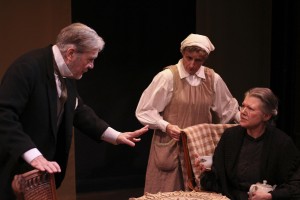In 1930, the theater artist Neith Boyce was commissioned to adapt H. G. Wells’s 1901 fantasy novel The Sea Lady for the stage. After five years of work, and with a Broadway production planned, Wells’s agent rescinded the rights to the novel, and the play was never seen. For decades the manuscript resided at Yale’s Beinecke Library, until Boyce’s biographer sent it to the Metropolitan Playhouse, which is currently staging the play’s world premiere under the direction (and design) of the company’s artistic director, Alex Roe.
State of the Union
In the middle of the last century, Howard Lindsay and Russel Crouse—producers, publicists, and prolific playwrights—were leading lights in the American entertainment industry. They are now remembered for writing Life with Father, the longest-running nonmusical play in Broadway history, and the libretto of The Sound of Music. Their 1945 hit State of the Union won the Pulitzer Prize and became a Frank Capra movie starring Spencer Tracy and Katharine Hepburn. That play is typical of the witty comedies with serious-minded underpinnings that Broadway audiences relished during World War II and after.
Shadow of Heroes
Shadow of Heroes, a gripping and sad tale, ruminates on the question: “Where does fraud begin and truth leave off?” It brings to life the true story of László (Trevor St. John-Gilbert) and Julia Rajk (Erin Beirnard), Marxist leaders in the Hungarian resistance during World War II. László and Julia are fierce and clear-eyed leaders whose actions helped create the post-war government in Hungary. But it is János Kádár (Michael Turner), a nebbishy friend who seems barely capable of carrying out the underground tasks asked of him, who survives the rise and fall of factions and, after the war, becomes a central figure in the newly formed government, while László and Julia are imprisoned and later martyred.
Ernő Gerő (David Logan Rankin, left), Hungarian party leader after the war, and László Rajk (Trevor St. John-Gilbert) talk candidly about politics. Top: Gerő (Rankin) toasts the new Hungarian Communist party with Beater, a partisan (Joseph J. Menino, left).
The portrait of Hungarians living under a totalitarian government is well wrought in Robert Ardrey’s gripping 1958 drama, directed by Alex Roe. The Author (Joel Rainwater) adeptly narrates the historical events, and there are many to follow, as the story outlines how politics is played like a chess game. After the war, László is made foreign minister. Someone asks, “When did he become foreign minister?” The response is “This morning.” But for each advance, there is a coup. László is soon accused of anti-party actions and imprisoned, tortured and hanged.
Ernő Gerő (a standout performance by David Logan Rankin), the Communist party leader after the war, cuts an imposing and sinister figure. Other characters, such as Viktor (H. Clark Kee), a cruel but bumbling general; his brutal son (James Ross; a talent to watch) who tortures the prisoners, including Rajk, show how personal views were redirected as political winds changed.
The Soviets played a complicated role in the Hungarian Revolution. Zenon Zeleniuch is the cold, emotionless Yuri Andropov, the Soviet ambassador to Hungary who helped suppress the revolution. He is not the only ideologue in this history lesson. When Gerő isn’t clear about something, he says, “Can’t you tell me something in party terms?”
László (John-Gilbert) (R), in the grip of Rakosi (Zenon Zeleniuch) (L) on his way to prison. Photographs by Emily Hewitt.
A very simple set (Vincent Gunn) of large wooden boxes, which are moved around to create scenes, gives a sense of the poverty of society during the Hungarian Revolution. Jessie Lynn Smith’s lighting, balancing light and dark, captures the shadowiness of both the actions of so many, as well as the way heroes (such as László and Julia) were cast to the corners during this tumultuous time. Sidney Fortner’s costumes expertly exaggerate the difference between peasants (in drab, worn-out clothing) and politicos (in sharp, well-cut suits). The actors play multiple roles and include Margaret Catov, Steve Humphreys and Joseph J. Menino.
“Don’t look at your watch,” László tells János. “Looking at a watch doesn’t change time.” How right he is. People disappeared, were killed quietly, or executed publicly. At one point, János is brought down from his political pedestal, imprisoned and tortured so badly his hand is crippled. But then he is appointed to head the party, where he served for more than 30 years. (It’s hard to keep track when government appointments changed like a game of musical chairs.) What is the cost of totalitarianism? The cost is the truth and everyone’s changes according to political need, and for their own protection, making even a simple thing like friendship a complicated and sometimes dangerous proposition.
Shadow of Heroes plays through Dec. 9 at the Metropolitan Playhouse (220 E. 4th St., between Avenues A and B). Evening performances are at 7 p.m. Monday through Wednesday and at 7:30 p.m. Thursday through Saturday; matinees are at 3 p.m. Sunday. To purchase ticket, call (800) 838-3006 or visit the box office or metropolitanplayhouse.org/shadow.
You and I
Maitland White, the protagonist of Philip Barry’s unjustly forgotten comedy You and I, has a blissful marriage, children on the cusp of adulthood and a highly remunerative corporate job. To all appearances, he’s the world’s most contented man, sharing a luxe existence with his loving family in the roaring days before the stock market crash of 1929. What no one around him knows is that Matey retains the great ambition of his youth. And, in middle age, that secret urge—to be a professional painter—is becoming increasingly insistent.
House of No
It is December 31, 1899. The Stanhope family has gathered to close up the home of Alison Stanhope, whose poetry has become famous in the nearly two decades since her death. The surviving Stanhope siblings—the slightly strange Agatha and straight-laced John—have carefully controlled their famous sister’s public reputation. Now, on the eve of a new century, the discovery of a secret stash of Alison’s writings exposes a stark divide between the generations.
Inspired by the life of Emily Dickinson, Alison’s House by playwright Susan Glaspell, won a Pulitzer Prize in 1931 despite negative reviews and a meager two-week run. It was one of a string of controversial picks by the Pulitzer committee that eventually led to the creation of the New York Drama Critics' Circle. Metropolitan Playhouse’s production may be the first uncut staging of the play in New York since 1931.
At the heart of Alison’s House is the question of whether duty and honor or personal happiness and self-realization are paramount. Elsa Stanhope, who alienated her father John and gave up her good name to run away with her married lover, represents the values of the younger generation. John and Agatha hold up the example of Alison, who in a similar circumstance chose her good name, became a recluse, and subsumed her love in writing.
Unfortunately, artistic director Alex Roe’s respectful staging of Alison’s House does not reveal a forgotten masterpiece. While the text is solid, charming and often amusing, the central conflict between Victorian values and a youthful desire for personal fulfillment must have seemed out of date even at the time of the original production. Some of the lack of urgency is due to the production’s uneven pace. While the bulk of the production is performed in a leisurely fashion, the actors race through the climactic moments of both acts.
Another problem comes from the lack of a strong antagonist. John D. McNally’s John Stanhope is so genial and warm that his role as the representative of the past, a forbidding father who upholds honor at all costs, becomes blurred. Other cast members struggle, too. Blaine Smith can’t quite overcome the fact that he seems a decade too old to play the puckish Ted Stanhope, while Matt McAllister and Katharine Scarborough come across as visitors from another broader play.
Standouts in the cast include John Long as the weary, harassed Eben Stanhope, and Anne Bates as his wife, Louise, who cannot earn love despite molding herself into an ideal Victorian wife and daughter-in-law. Amanda Jones’ performance as Elsa is the highlight of the evening. Her touching performance drives scene after scene in the final act.
Roe has staged the play on a compact thrust stage, which transforms during intermission from a library in the public part of the house to Alison’s private bedroom, where all her secrets are revealed. The set serves the play well, especially during scenes involving many characters, although there are some problems with sightlines during intimate scenes (especially the play’s climax). Sidney Fortner’s costume design neatly illustrates the generational and social divides between the characters in Alison’s House. While the elder Stanhopes are clothed in sober browns and blacks, the younger members of the family—especially Ted and Elsa—wear brilliant red.
Metropolitan Playhouse’s production is a solid presentation of an underwhelming script. Still, it is a good opportunity to see a rarely staged work by the much-anthologized Glaspell. Perhaps Glaspell’s farewell to the Victorian age, with its rigid, hoary values, can still speak to the present day. Even now, young people struggle to find fulfillment in ways that make their parents want to shake their heads and say, as John Stanhope does, “I cannot bear your youth.”
Alison's House is running at the Metropolitan Playhouse (220 East 4th St. between Avenue A and B) in Manhattan until Dec. 13. Performances are at 7:30 p.m. on Thursday-Saturday and 3 p.m. on Wednesday, Saturday and Sunday. Tickets: $25 for general admission, $20 for students/seniors and $10 for children. To purchase tickets, call 800-838-3006 or visit www.metropolitanplayhouse.org/













